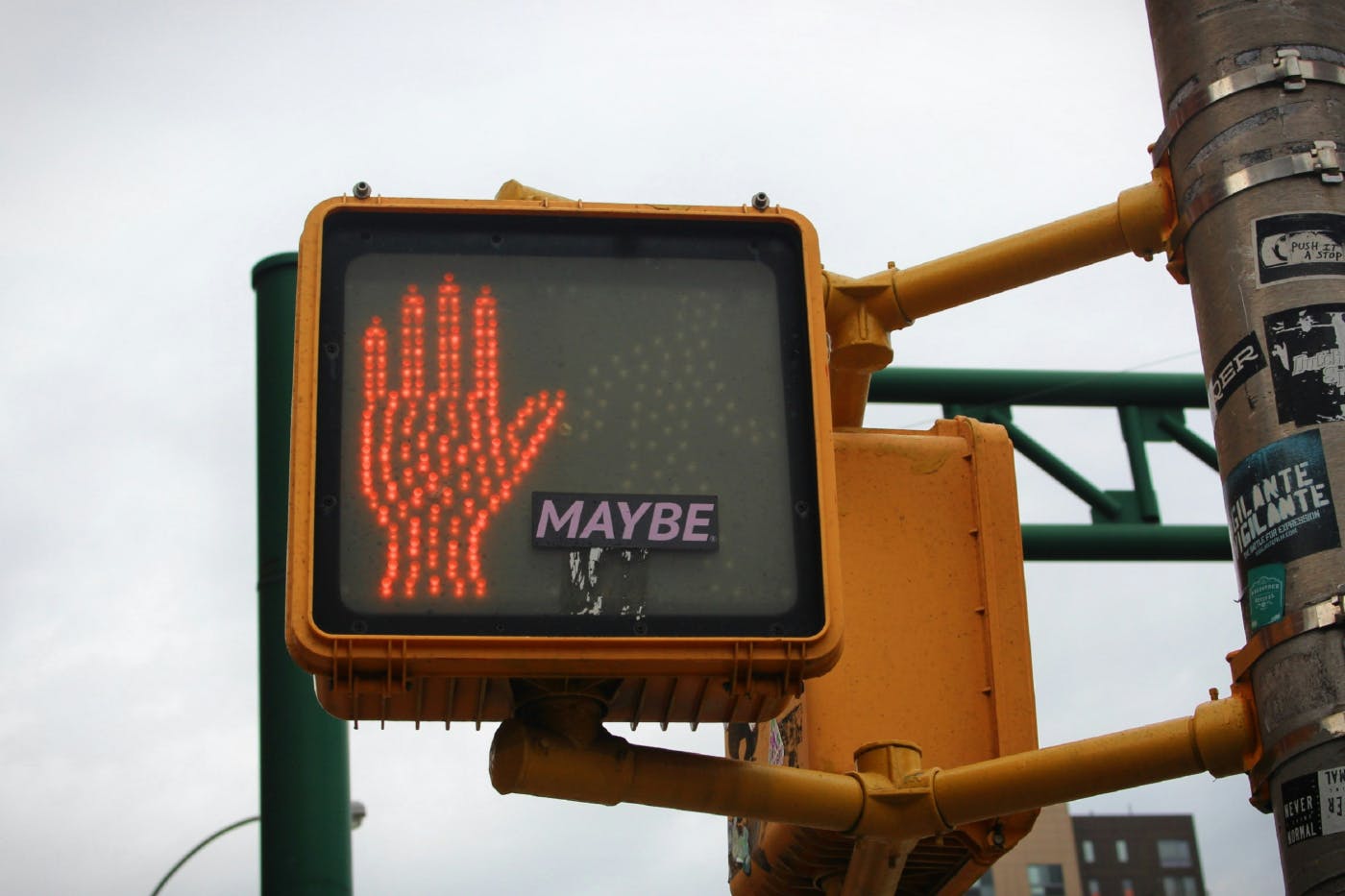
There’s a moment in almost every project—right after the pitch deck has landed, the mockups are up, and the silence has stretched just a beat too long—when a client breaks the tension with a classic:
“Can we just… make it pop?”
Years ago, when I was a grunt working for Disney—doing street improv and working the odd special event—there came a night when a very wealthy individual had rented out part of the park. These things happened from time to time. Some company or loaded someone would pay a fortune to have a ride, a section, or even the whole park to themselves, and we, the street performers, were brought in as roaming entertainment.
Before one such event kicked off, the director gathered the dozen of us together to meet the client. A very thin man in a very expensive suit stood before us and said, “Thanks for doing this—we’re all excited to make this a memorable evening. For your part, we’d like you to be funny… but not… wheeeeeird.”
He really aspirated the 'h' in weird, like he was afraid just saying the word might summon something unspeakable.
He emphasized it a second time. Please, not weird.
Naturally, we all took that as a challenge.
We went out there and were as wonderfully weird as we could be. Not inappropriate. Not off-brand. Just high-energy, offbeat, and a little unhinged in all the right ways. And wouldn’t you know it? There were no complaints. Only joy and laughter. The event was a hit.
We laughed about that guy for weeks. “Be funny, but not weird” became a sort of troupe mantra. To this day, none of us knows what he meant—or what he was afraid of. But we just jumped in and ran with it.
To this day, I still don’t know what that man was trying to say. But I’ve heard a version of it in almost every creative job I’ve ever had. Vague, contradictory, impossible-to-define feedback is basically the native language of branding and marketing.
So, in honor of that aspirated plea—not wheeeeeird—let’s take a look at some of the all-time greatest hits in the creative feedback hall of fame.
Just Make It Pop – The Greatest Hits
There’s a moment in almost every project—right after the pitch deck has landed, the mockups are up, and the silence has stretched just a beat too long—when a client breaks the tension with a classic:
“Can we just… make it pop?”
They say it like it's a minor tweak. A nudge. A tiny flavor boost. But if you’ve been in the game long enough, you know: pop is a loaded word. It might mean color. It might mean layout. It might mean “I don’t feel anything yet, and that scares me.”
That’s the truth behind a lot of these Greatest Hits of feedback. They sound like design notes. But they’re really emotional SOS signals from people trying to articulate something they don’t have the words for yet.
Some other award-winning entries:
“I’ll know it when I see it.”
Often said with confidence, as if the person is moments away from divine revelation. Translation: I don’t know what I want, but you’ll be punished for not giving it to me anyway.
“Can we try every version?”
This isn’t about exploring options—it’s about avoiding responsibility. If I don’t choose, I can’t be wrong.
Also known as the “52 flavors of the same ice cream” approach.
“It needs more… jazz.”
Vibes-based feedback at its finest. They want energy. Or surprise. Or a saxophone? Sometimes it helps to lean in and ask, “Do you mean metaphorical jazz or literal jazz?” The answer will be equally unclear.
“Can we make the logo bigger, but more subtle?”
A koan for the modern brand strategist. It’s like asking for louder silence. (But you still try. Because you’re a professional.)
“This is great. Can we just change the colors, the layout, the copy, and the tone?”
This is the nice version of saying, “I hate it.” And hey, we appreciate the attempt at kindness. Really, we do.
But here’s the thing: these moments aren’t failures. They’re part of the creative process. A frustrating part, sure. But also a necessary one. Branding is subjective. Personal. Messy. Clients aren’t trying to be difficult—they’re trying to make sense of something that lives in their heads and hearts, but hasn’t made it to the surface yet.
So when they say, “make it pop,” they’re often saying, “I want to feel something.”
And when they say, “I’ll know it when I see it,” what they really mean is, “I’m scared to choose wrong.”
That’s the secret job no one tells you about in branding. You’re not just designing. You’re translating uncertainty. Giving shape to someone else’s gut feeling. Pulling clarity out of chaos, one “pop” at a time.
That’s the secret job no one tells you about in branding. You’re not just designing. You’re translating uncertainty. Giving shape to someone else’s gut feeling. Pulling clarity out of chaos, one “pop” at a time.
And while we usually smile and nod and say, “Of course, we’ll take another pass,” what we’re actually thinking is… well. That’s another story.

What We Wish We Could Say (But Don’t)
There’s an art to smiling through feedback that makes your brain melt a little.
Because while we nod politely and promise to “explore that direction,” what we’re really thinking is often closer to:
“You want a timeless trend? That’s not a thing. That’s a contradiction in terms. Like a fast glacier.”
“If you don't trust the process, why did you hire experts and then throw us into a blender of LinkedIn buzzwords and your cousin’s unsolicited ideas?”
“No, we can’t make it ‘edgy, clean, friendly, disruptive, and corporate’ all at once. That’s like asking for a punk rock bar mitzvah in a bank lobby.”
We don’t say these things. Of course not. We're professionals. We translate. We soothe. We smile like overly caffeinated diplomats. But inside? Inside, we’re writing this blog.
Because every creative has a secret list—the things we’d love to say in a meeting but can’t. Things like:
“Your request for ‘more jazz’ makes me want to walk into the sea.”
“If I make the logo any bigger, it will legally become the brand.”
“You’re not in a branding crisis. You’re just bored.”
But we don’t say it. We vent in private, laugh with our teams, and then we go back and do what we do best: we take the abstract, the impossible, the incoherent—and we turn it into something that actually works.
And every once in a while, when the stars align and the weirdness is just right, we get to say the rarest phrase in all of branding:
“Nailed it on the first try.”
It’s rare. Mythical. Like a unicorn wearing a perfectly kerned typeface. But it happens.
Still, for all the moments we can’t say what we’re thinking, the work is worth it. Because when you break through—when the client sees it, feels it, gets it—there’s nothing better.
That said, it’s probably a good time to talk about the hidden power move in every creative conversation. The real fulcrum of influence. The unspoken tool we all use, whether we know it or not.
Still, for all the moments we can’t say what we’re thinking, the work is worth it. Because when you break through—when the client sees it, feels it, gets it—there’s nothing better.
And yet, every step of the way, there’s something else at play. Something unspoken, but always present. It’s in the way feedback is delivered, in who talks first in the room, in how many times someone says “just a thought…”
It’s not in the brief. It’s not in the scope. But it shapes everything. What is it, you ask?
Status.
Status – The Unspoken Force in Every Creative Conversation
Status isn’t about job titles. It’s not about who drives the nicer car or who has more followers on LinkedIn. In creative work—especially in branding—it’s way subtler than that.
It’s who apologizes first.
It’s who gets interrupted.
It’s whose feedback gets taken as gospel and whose ideas get “tabled for now.”
And once you see it, you can’t unsee it.
In every meeting, pitch, brainstorm, or brand presentation, status is shifting constantly. Sometimes it's a power suit and a booming voice. Sometimes it's just the way someone sighs after you share a concept.
You may walk in with the strategy, the research, and the right answer. But if your status is low, all it takes is one client saying, “Hmm, I don’t know… it’s not grabbing me,” and suddenly the whole room is nodding like you’ve shown them a ham sandwich instead of a fully baked brand.
Other times, someone with high status can say, “I just think this color feels… triumphant,” and everyone reacts like they’ve just witnessed a TED Talk.
It’s not always fair. It’s not always rational. But it’s real.
That’s why so many creatives spend half their energy managing the room, not just presenting ideas, but reading the temperature, adjusting their tone, deferring here, asserting there. Because the work isn’t just about the work, it’s about how it’s received—and who’s allowed to shape that reception.
So we play the game. We laugh at the feedback. We say “good note” even when it’s a dagger. We know that in the strange dance of creative collaboration, raising or lowering our own status—or someone else's-is one of the most powerful tools we have.
But what does that look like, exactly? How do we shift status in real time, and why does it matter?
Let’s go there.

Raising and Lowering Status – The Real Power Moves
Here’s the secret they don’t teach in business school: status isn’t fixed. It moves.
And if you know how to move it—up, down, sideways—you can change the entire dynamic of a conversation, a project, even a relationship. You can calm tension. Build trust. Or, if you’re not careful, tank a meeting in ten seconds flat.
You’ve probably done it without realizing.
Ever said, “I’m just throwing this out there…” before presenting an idea you spent three days obsessing over?
Congratulations. You just lowered your own status.
Ever interrupted someone to “build” on their thought but ended up rerouting the whole discussion back to your point?
That’s a subtle status grab.
Ever told a client, “That’s a great point,” even when it absolutely wasn’t?
That’s a tactical status raise—you’re elevating them so they feel heard (and maybe more open to your actual suggestion two minutes later).
These moves aren’t inherently good or bad. They’re just part of the dance. The trick is knowing when to raise, when to lower, and when to hold your ground.
Here are a few classic status moves in the creative world:
Raising someone else’s status:
“That’s a great insight. I hadn’t thought of it that way.”
Used to build rapport or soften resistance.
Lowering your own status (strategically):
“I might be off here, but one thing we’ve seen work well is…”
Used to invite collaboration or reduce perceived threat.
Holding high status gently:
“Here’s what we’ve learned from the research—and why this direction works.”
Used to maintain authority without triggering ego defenses.
Fake-lowering status (the humblebrag):
“We’re just trying to do work we can be proud of. Like the five brands we helped last quarter triple their engagement.”
Used when someone’s playing chess instead of checkers.
When these moves are done well, they make collaboration feel smooth, even fun. When they’re off—when someone clings too tightly to high status or tries too hard to be “nice”—things get weird fast.
And if you really want to see status acrobatics in action? Step into a client presentation where the CMO, the Head of Brand, the junior marketing associate, and the CEO’s nephew are all in the same room. That’s not a meeting—it’s a status Thunderdome.
Which brings us to one of the highest-stakes zones for status management in all of branding…
Negotiation.
Status in Negotiation – Who’s Really Holding the Pen?
If status is always present in creative conversations, then negotiation is where it steps into the spotlight, puts on a headset mic, and delivers a keynote.
Because negotiation isn’t just about money, it’s about who has the leverage, who frames the ask, and who’s allowed to say no without flinching. It’s about who walks in feeling like they belong at the table—and who walks in hoping not to be asked to leave.
We’ve all been in those rooms. The client pushes for scope without budget. You push back, but not too hard. You use phrases like “Let’s explore” and “Maybe there’s a version of this that works” while trying not to look like you’re doing the mental math of how many hours you’ll be working this weekend.
And then someone says it:
“Can’t you just tweak the existing version?”
And now you're negotiating against the ghost of your own previous work.
In these moments, the way you manage status can change everything. A high-status move might be a clear, confident boundary:
“We’re excited about that direction—it would require additional time, so let’s talk through how that fits into the scope.”
A lower-status move (often made out of fear) sounds more like:
“Yeah, totally! We can just kind of… see what we can do!”
And sometimes, ironically, raising the client’s status can give you more room to stand your ground:
“You’ve got a strong instinct for what’s landing—we want to give this the attention it deserves. That’ll take some additional resources, but the result will be stronger.”
It’s all in the dance. The wording. The posture. The pauses.
This is why creative work can feel exhausting, even when everyone’s technically being “nice.” Because negotiation, when layered with power, personality, and the weird emotional terrain of branding, becomes a delicate, high-stakes balancing act.
And now that we’ve talked about how status plays out in the room, let’s talk about where it lives 24/7:
Online.

Status in the Digital Age – The Always-On Stage
In the analog world, status was situational. It shifted in rooms, in roles, in real time. But online?
It’s permanent. Or at least, it feels that way.
The moment you post, share, tweet, comment, or click “attend,” you’re signaling status. Not just your professional rank or your personal brand, but your alignment, your relevance, your place in the hierarchy of now.
We’ve traded watercooler moments for algorithmic reputation management.
Even the most casual online behavior carries weight:
Who liked your post?
How fast did they respond?
Did your idea get reposted or politely ignored?
Every heart, clap, emoji, and view count becomes part of your perceived status score.
And brands? They’re not exempt. A brand that doesn’t respond to comments looks aloof. One that responds too quickly, or too eagerly, might seem desperate. One misstep—one badly timed joke, one poorly handled complaint—and status plummets. Publicly. In real time.
This is why so many brands are now performing “relatable.” It’s a subtle status move. You lower yourself just enough to be liked. To be seen as accessible. Human. But not too much—because if you lower your status too far, you lose authority. You become a meme.
(Unless that’s the strategy. In which case, congrats. You’ve achieved viral martyrdom.)
Online, status is constantly negotiated through tone, timing, and context. The brand that can post a humble apology and a confident product launch within the same week? That’s high-status wizardry.
And behind every tweet, every campaign, every “we’re listening” moment… there’s a creative team managing the perception, balancing the tone, and praying to the gods of engagement that this doesn’t turn into a 72-hour crisis.
So yes, status lives in the room. But it also lives in the feed. On the landing page. In the email subject line.
It’s always on. Always shifting. And if you know how to read it, it tells you everything.
Summing Up – Be Funny, But Not Weird
When that man in the expensive suit asked us to “be funny, but not… wheeeeeird,” we all laughed. Later, of course. After we’d ignored him completely.
But looking back, that moment feels oddly prophetic. Because “funny but not weird” is basically the brief for every brand right now. Be bold, but not too risky. Be fresh, but familiar. Be confident, but don’t come off like you’re trying too hard.
And under all of it? The same invisible forces: feedback wrapped in abstraction, status quietly steering the conversation, and creative people trying to translate vibes into clarity.
That’s the job.
At ThoughtLab, we live in this space. We navigate the absurd, decode the vague, and manage the delicate dance of status and strategy with a smile. Because we know that even when the feedback makes no sense—even when the ask is “make it pop, but subtle, but louder, but more timeless”—there’s always a way through.
We find it. We name it. We shape it into something that works.
So go ahead. Be funny. Be weird. Or don’t.
We’ll help you figure it out.
Open Question
What’s the wildest piece of feedback you’ve ever received—and how did you actually respond?

